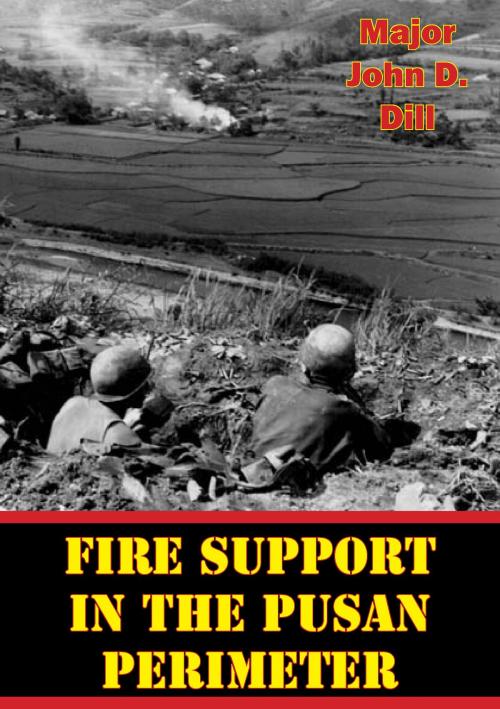| Author: | Major John D. Dill | ISBN: | 9781786252210 |
| Publisher: | Normanby Press | Publication: | November 6, 2015 |
| Imprint: | Normanby Press | Language: | English |
| Author: | Major John D. Dill |
| ISBN: | 9781786252210 |
| Publisher: | Normanby Press |
| Publication: | November 6, 2015 |
| Imprint: | Normanby Press |
| Language: | English |
Five years after emerging victorious from World War II, the United States became embroiled in the Korean War. In August of 1950, despite the relative industrial and technological disadvantages suffered by the enemy North Korean Peoples’ Army, the American Eighth Army was nearly defeated and pushed into the sea while trying to defend a toehold on the Korean peninsula around the port of Pusan. The poorly trained and equipped U.S. soldiers and marines defending the Pusan Perimeter relied heavily on fire support assets to stem the tide and defeat the North Korean attack.
This monograph asks if the fire support, including both artillery and air fires, provided to the Eighth Army Infantry and Armor units was effective. It also examines the reasons for the success or failures of fire support by contrasting the use of fire support by different Army and Marine Corps units as they defended the perimeter. Additionally, the monograph addresses the question of how the force development process shaped the success or failure of the Pusan fire support effort. Finally, the monograph discusses lessons from the Pusan defense that are applicable to current fire support and force development.
The monograph concludes that the fire support effort in the Pusan campaign was effective. However, because of the force reductions and training lapses that occurred after World War II in the United States Army and Air Force, it was not as effective as it could have been. The time taken to relearn the lessons of World War II and to rebuild units to doctrinal war time strength needlessly cost lives. The Pusan perimeter fight contains valuable lessons for current fire support leaders as they grapple with challenges similar to those faced by their predecessors in the summer of 1950.
Five years after emerging victorious from World War II, the United States became embroiled in the Korean War. In August of 1950, despite the relative industrial and technological disadvantages suffered by the enemy North Korean Peoples’ Army, the American Eighth Army was nearly defeated and pushed into the sea while trying to defend a toehold on the Korean peninsula around the port of Pusan. The poorly trained and equipped U.S. soldiers and marines defending the Pusan Perimeter relied heavily on fire support assets to stem the tide and defeat the North Korean attack.
This monograph asks if the fire support, including both artillery and air fires, provided to the Eighth Army Infantry and Armor units was effective. It also examines the reasons for the success or failures of fire support by contrasting the use of fire support by different Army and Marine Corps units as they defended the perimeter. Additionally, the monograph addresses the question of how the force development process shaped the success or failure of the Pusan fire support effort. Finally, the monograph discusses lessons from the Pusan defense that are applicable to current fire support and force development.
The monograph concludes that the fire support effort in the Pusan campaign was effective. However, because of the force reductions and training lapses that occurred after World War II in the United States Army and Air Force, it was not as effective as it could have been. The time taken to relearn the lessons of World War II and to rebuild units to doctrinal war time strength needlessly cost lives. The Pusan perimeter fight contains valuable lessons for current fire support leaders as they grapple with challenges similar to those faced by their predecessors in the summer of 1950.

![Cover of the book Last Flight From Saigon [Illustrated Edition] by Major John D. Dill](https://www.kuoky.com/images/2014/august/300x300/9781782898955-WJAZ_300x.jpg)
![Cover of the book My Three Years In Manipur And Escape From The Recent Mutiny [Illustrated Edition] by Major John D. Dill](https://www.kuoky.com/images/2014/august/300x300/9781782895350-I2Wb_300x.jpg)

![Cover of the book Air Power And The Fight For Khe Sanh [Illustrated Edition] by Major John D. Dill](https://www.kuoky.com/images/2015/november/300x300/9781786250148-lmSt_300x.jpg)

![Cover of the book Mutiny Memoirs: Being Personal Reminiscences Of The Great Sepoy Revolt Of 1857 [Illustrated Edition] by Major John D. Dill](https://www.kuoky.com/images/2014/august/300x300/9781782899174-JQlv_300x.jpg)








